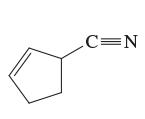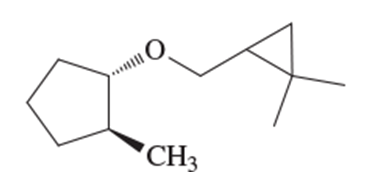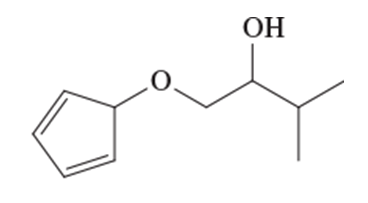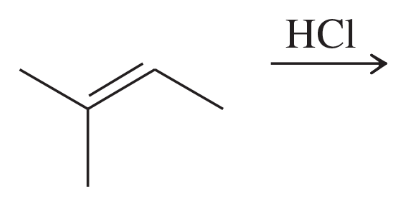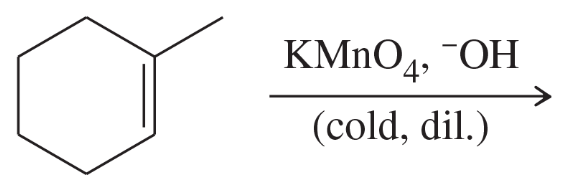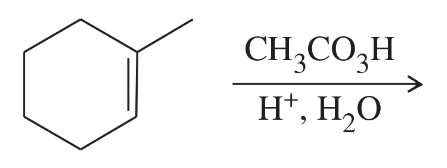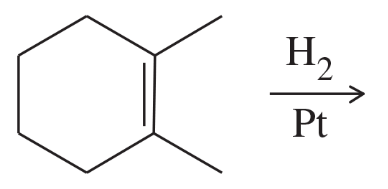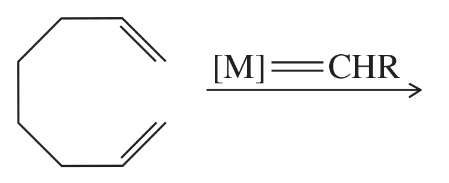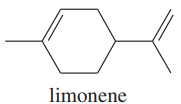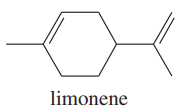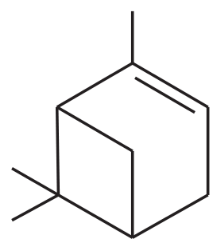 Back
BackProblem 38
a. Propose a mechanism for the following reaction.
2 (CH3)2C=CH–CH3 + cat. H+ → 2,3,4,4-tetramethylhex-2-ene
b. Show the first three steps (as far as the tetramer) in the BF3–catalyzed polymerization of propylene to form polypropylene.
Problem 43
Propose a mechanism for the triolefin process using a metal alkylidene as the catalyst.
Problem 44
Show what reagents would be needed to synthesize the pheromone of the omnivorous leafroller (OLR) using olefin metathesis to assemble the molecule at the double bond.
Problem 45a
Show how you would synthesize each compound, starting with alkenes or cycloalkenes that contain no more than six carbon atoms. You may use any additional reagents you need.
(a)
Problem 45b
Show how you would synthesize each compound, starting with alkenes or cycloalkenes that contain no more than six carbon atoms. You may use any additional reagents you need.
(b)
Problem 45c
Show how you would synthesize each compound, starting with alkenes or cycloalkenes that contain no more than six carbon atoms. You may use any additional reagents you need.
(c)
Problem 46a
Predict the major products of the following reactions, and give the structures of any intermediates. Include stereochemistry where appropriate.
(a)
Problem 46b
Predict the major products of the following reactions, and give the structures of any intermediates. Include stereochemistry where appropriate.
(b)
Problem 46c
Predict the major products of the following reactions, and give the structures of any intermediates. Include stereochemistry where appropriate.
(c)
Problem 46d
Predict the major products of the following reactions, and give the structures of any intermediates. Include stereochemistry where appropriate.
(d)
Problem 46h
Predict the major products of the following reactions, and give the structures of any intermediates. Include stereochemistry where appropriate.
(h)
Problem 46i
Predict the major products of the following reactions, and give the structures of any intermediates. Include stereochemistry where appropriate.
(i)
Problem 46j
Predict the major products of the following reactions, and give the structures of any intermediates. Include stereochemistry where appropriate.
(j)
Problem 46k
Predict the major products of the following reactions, and give the structures of any intermediates. Include stereochemistry where appropriate.
(k)
Problem 46l
Predict the major products of the following reactions, and give the structures of any intermediates. Include stereochemistry where appropriate.
(l)
Problem 46m
Predict the major products of the following reactions, and give the structures of any intermediates. Include stereochemistry where appropriate.
(m)
Problem 46n
Predict the major products of the following reactions, and give the structures of any intermediates. Include stereochemistry where appropriate. n
(n)
Problem 46o
Predict the major products of the following reactions, and give the structures of any intermediates. Include stereochemistry where appropriate.
(o)
Problem 46p
Predict the major products of the following reactions, and give the structures of any intermediates. Include stereochemistry where appropriate.
(p)
Problem 46q
Predict the major products of the following reactions, and give the structures of any intermediates. Include stereochemistry where appropriate.
(q)
Problem 47a
Limonene is one of the compounds that give lemons their tangy odor. Show the structures of the products expected when limonene reacts with an excess of each of these reagents.
a. borane in tetrahydrofuran, followed by basic hydrogen peroxide
Problem 47b
Limonene is one of the compounds that give lemons their tangy odor. Show the structures of the products expected when limonene reacts with an excess of each of these reagents.
b. m-chloroperoxybenzoic acid
Problem 47c
Limonene is one of the compounds that give lemons their tangy odor. Show the structures of the products expected when limonene reacts with an excess of each of these reagents.
(c) ozone, then dimethyl sulfide
Problem 47d
Limonene is one of the compounds that give lemons their tangy odor. Show the structures of the products expected when limonene reacts with an excess of each of these reagents.
d. a mixture of osmic acid and hydrogen peroxide
Problem 47e
Limonene is one of the compounds that give lemons their tangy odor. Show the structures of the products expected when limonene reacts with an excess of each of these reagents.
(e) hot, concentrated potassium permanganate
Problem 47f
Limonene is one of the compounds that give lemons their tangy odor. Show the structures of the products expected when limonene reacts with an excess of each of these reagents.
f. peroxyacetic acid in acidic water
Problem 47i
Limonene is one of the compounds that give lemons their tangy odor. Show the structures of the products expected when limonene reacts with an excess of each of these reagents.
(i) hydrogen bromide gas in a solution containing dimethyl peroxide
Problem 47m
Limonene is one of the compounds that give lemons their tangy odor. Show the structures of the products expected when limonene reacts with an excess of each of these reagents.
m. CHBr3 and 50% aq. NaOH
Problem 48a,b
Give the products expected when the following compounds are ozonized and reduced.
(a)
(b)
Problem 48c,d
Give the products expected when the following compounds are ozonized and reduced.
(c)
(d)



